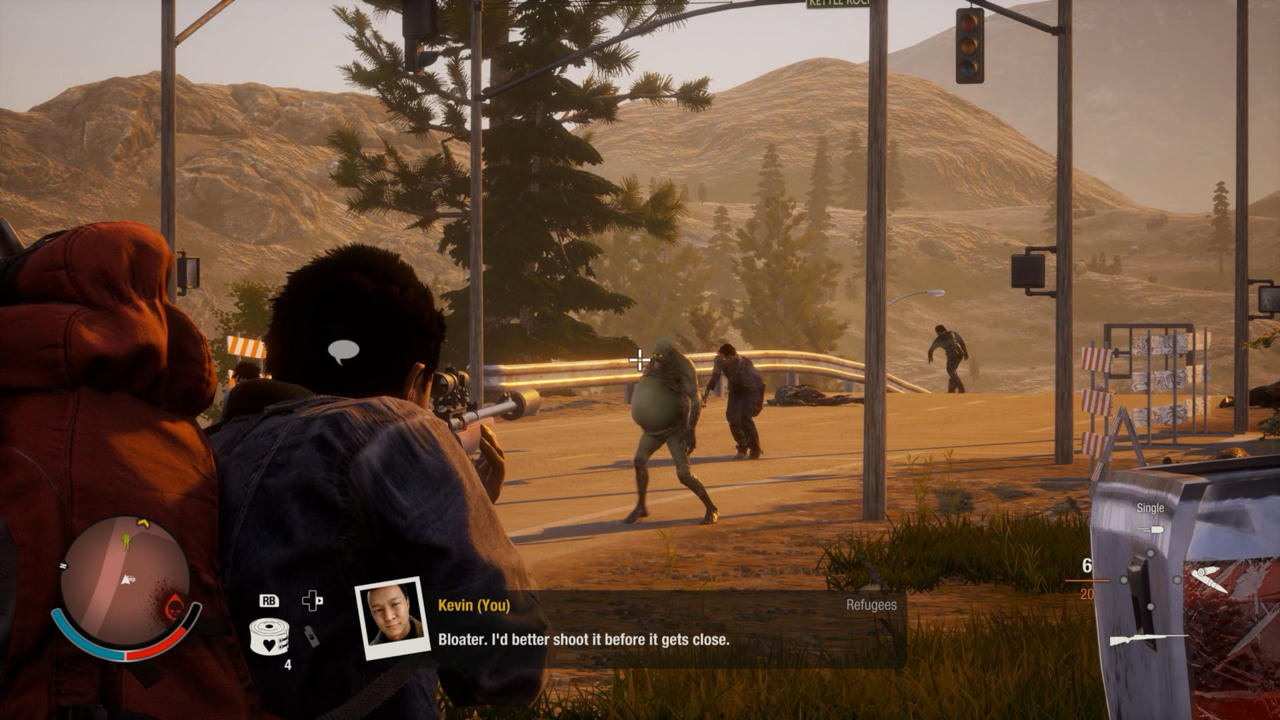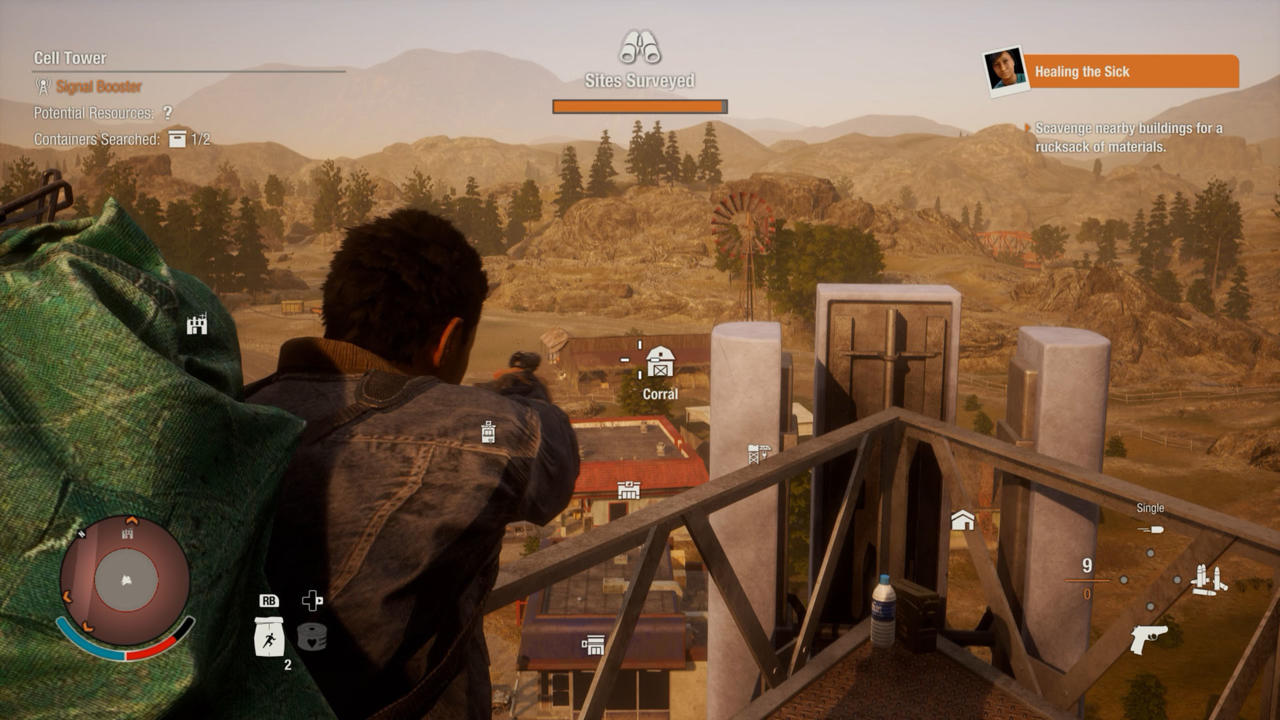State of Decay 2 sometimes feels like a far-too-real representation of the mundane reality that comes with surviving a zombie apocalypse. Consistently being on the hunt for food, resources to craft ammunition, and survivors to bolster your ranks doesn’t always translate into a captivating gameplay loop--especially when you’re faced with horrors other than the countless undead that roam around you.
Like the first game from Undead Labs, State of Decay 2 infrequently checks in with an overarching narrative. You’re given the choice of three pairs of survivors to start off with, each with their own bare-bones background stories. Those stories don’t really matter, but your decision does define your starting area and the preliminary survivors you’ll team up with to combat a growing sickness called the Blood Plague. The plague is the singular goal for you to work against, as your community strives to eradicate it from your town and build towards a brighter future.
That mission boils down to finding zombie-invested settlements that you’ll need to first scout out and ultimately destroy, with grotesque, beating Plague Hearts at the center. These fights are the only real way to measure progression through State of Decay 2’s otherwise open-ended campaign. Each settlement you conquer strengthens the rest, forcing you to step back and regroup before attempting to blow up the next. They're the toughest challenges the game has to offer, too, serving up waves of foes for you to fight as you valiantly lob another Molotov at the heart, hoping it vaporizes and takes all the nearby undead with it. Unfortunately, they are basic action set-pieces at their core, without much variety to help shake up the otherwise monotonous scavenging that surrounds them.

State of Decay 2 is primarily about survival, and it bears all the baggage the genre is known for. Although you’re spared the stress of dealing with individual meters for hunger and thirst, you’ll instead be engaging with ones that affect your community. Food, medical supplies, and crafting materials all factor into the stability of your community, with the overall mood of your survivors governing how well you’re doing. Supplies are littered around the dilapidated and abandoned settlements surrounding you, which are easily scouted with a little high ground. Your objectives hardly stray from going out, clearing an area of enemies, and scrounging around for consumables, gear, and large rucksacks of the more pertinent supplies you’ll need to keep settlers happy.
The act of gathering these supplies is rarely gratifying, though. Although your settlement initially requires some quick work to get on its feet, State of Decay 2 hardly feels like it will fail you for slacking on your routine duties. Certain base structures, for example, have daily resources costs that might trick you into thinking you’ll need a steady supply coming through. But because days tick by so slowly (I finished my core objectives within the first 10 days) this never becomes a real concern. Resources only become troublesome when you need them to craft something specific, such as ammo or plague cures. They’re short-lived problems though, which hardly force you to pause and think about how you’re setting up your settlement. It’s rare for State of Decay 2 to make you feel pressure over the choices you make, which just make all of its interesting sub-systems feel shallow.
It’s a pity, too, because so many of them could’ve added a much-needed layer of strategy. As an example, your base features a threat level which governs how likely you are to attract a zombie attack. Creating new structures or powering them with generators creates noise and in turn increases the likelihood of an attack for a certain period. But even at the highest level, a community of just six members strong is often enough to fend off these attacks without needing explicit intervention on your part. Of the handful of moments that my character was radioed to return, the fight was over by the time I arrived. All structures intact, all survivors unharmed.
State of Decay 2 squanders systems like this by not giving you a reason to engage with them seriously. If your aim is to continually bring new survivors to a settlement but also worry about their well-being, your encounters with each new face should feature more scrutiny as to what they bring to the table. Their distinct abilities set them apart from each other, but not in a way that forces you to make tough decisions about who to invite into your settlement.
The friendlier survivors you encounter are injected with a sense of individuality thanks to numerous perks that come pre-assigned to them. One specialising in swordplay will be more effective with a bladed weapon, while another with computer skills can help expand your base of operations. The sheer breadth of options on offer might trick you into thinking that scrutinizing each potential new addition to your settlement is key, but that’s not the case. Frequently, State of Decay 2 informs you that clashing personalities are leading to fights at home base, but these never escalate to a point where you’re required to take action. You’ll never feel the need to exile an existing character or deny entry to one based on their lack of specific skills.
Graphical hitches are frequent, including enemies clipping through the environment and sometimes having entire hordes stuck on single piece of the environment.
Combat isn’t as dynamic as some character-specific abilities might suggest, but it is satisfying nonetheless. A single button is used for attacks, which depending on your weapon of choice could inflict blunt knockback damage and force an enemy to the floor or slowly slice away at them limb by limb. Each approach comes with its advantages and drawbacks. Bladed weapons deal with larger groups of enemies more efficiently but tend to be far less durable than a sledgehammer or tire iron. These bulkier weapons require you to take an additional action to finish off enemies on the ground, which might leave you open to getting surrounded. Either way, the gory finishers and gruesome sound effects really bring a weight to the melee action, even if you’re just mindlessly mashing the same button until your stamina expires. Firearms feature too, and ammunition for them is far more abundant than you might expect. Gunshots attract more zombies (even with silencers), but it’s the sluggish aiming that's ultimately more frustrating in practice.
State of Decay 2 does a fair job of mixing things up with the introduction of some new enemy types. While some less interesting additions suchs as exploding Bloaters feature more than they deserve to, two others shake up combat in delightful ways. Ferals will jolt around at high speeds, avoiding your melee swings and making firearms a nightmare to connect with. Similarly, Juggernauts make up the largest foes you’ll face on the frontier. They’ll soak up hits from vehicles and rounds of ammunition before giving you a chance to take them down with a satisfying execution. Combined with regular, lumbering enemies that will quickly surround you, Juggernauts make fights more about clever crowd control.

Often though, it’s the game itself that will do its best to deter you from playing rather than its lack of depth. State of Decay 2 runs extremely poorly, even on Xbox One X. Despite not standing out graphically in any regard, the framerate will frequently dip well below its 30 frames per second target, sometimes locking up momentarily when the action is thick on screen. As a result, inputs can often feel incredibly sluggish and unresponsive, which just becomes annoying when you’re trying to swing your way out of a supply run gone sideways. Lighting can sometimes be striking, especially in dawn and dusk situations, but State of Decay 2 lacks a visual theme to tie itself up with and just ends up looking drab and boring. This is all stacked on top of a motion blur that is so aggressive that even the slightest movement turns your surroundings into an unattractive smudge.
Bugs are prominent too and can range from slightly annoying to near game-breaking. Graphical hitches are frequent, including enemies clipping through the environment and sometimes having entire hordes stuck on single piece of the environment. Enemies also routinely drop from the sky if you’re racing across the map quickly, which you’ll do often when you’re travelling in any one of the vehicles present on the map. Physics will miscalculate, launching your vehicle in the air from a slight touch at low speeds. Companions are also particularly prickly. Some following you on missions will disappear for no reason, while I personally had a single instance of a community member disappearing entirely and being eliminated from my pool of characters upon starting the game. One other instance saw one of my characters locked out from use in perpetuity for no apparent reason, while other times some would be stuck in an endless loop of the same boring dialogue for an entire mission. State of Decay 2 is in rough shape as it stands.
Perhaps if State of Decay 2 had the kind of depth that drew you in, these technical faults would be easier to overlook. But it’s because of the lack of meaningful motivations that they stick out so predominantly. State of Decay 2 settles into a rhythm that might be easy for you to pass some hours with, but it’s never a ride with genuine surprises, excitement or purpose. There’s promise in so many systems that it introduces, but they’re woefully underutilized to make space for repetitive activities that are nowhere near as exciting to engage with. State of Decay 2 feels like the lumbering enemies that populate its country mountains. Aimless, wandering, and just out of place.













